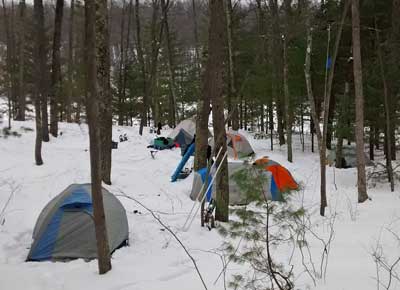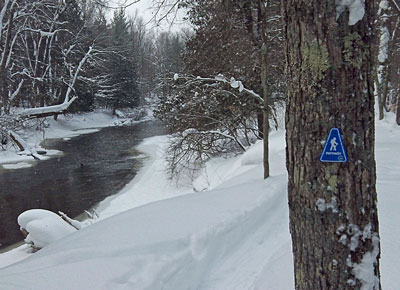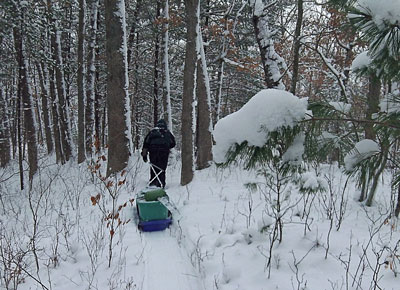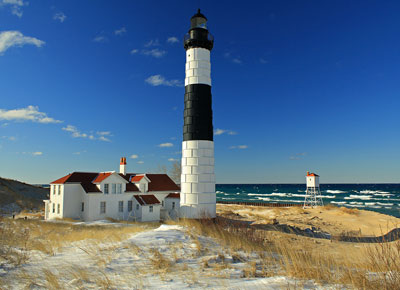7. Base Layer - When you are outside and being active in the winter a good base layer is the most import thing for keeping you comfortable. You will want something that fits close to your skin made from either a synthetic or wool materials that will dry fast and wick away moisture. Avoid cotton because it holds the moisture and does not insulate well when wet. I use a SmartWool Long Sleeve Shirt paired with Patagonia Capilene Mid Weight Bottoms. The SmartWool Shirt was a gift and is a new favorite of mine. It dries fast and because it is made from wool it can be worn a few days in a row and still stay fairly fresh. I usually take a second base layer in case I need something dry to sleep in. . I suppose that you could "go commando" under your base layer, but I choose the quick drying and odor resistant ExOfficio Give-N-Go Boxers paired with Patagonia Capilene Mid Weight Bottoms. The SmartWool Shirt was a gift and is a new favorite of mine. It dries fast and because it is made from wool it can be worn a few days in a row and still stay fairly fresh. I usually take a second base layer in case I need something dry to sleep in. . I suppose that you could "go commando" under your base layer, but I choose the quick drying and odor resistant ExOfficio Give-N-Go Boxers . If someday I win the lottery I will get some of these for everyday of the week. . If someday I win the lottery I will get some of these for everyday of the week.
 8. Coats - A water proof and breathable shell is a must for winter camping. If you do not already have one look for something with a big hood and a built in 8. Coats - A water proof and breathable shell is a must for winter camping. If you do not already have one look for something with a big hood and a built in visor to help keep the snow out. I have an old Columbia
visor to help keep the snow out. I have an old Columbia jacket that I bought for skiing back in high school that I still really like. I would advise spending the money to get something good and keep it forever. Along with my shell I take a mid weight fleece coat, light weight fleece shirt and a soft shell vest. All of this gives me several layering options that I can customize for any weather. I find that most of the time for hiking I wear my North Face Lightweight 1/4 Zip Fleece and Soft Shell Vest
jacket that I bought for skiing back in high school that I still really like. I would advise spending the money to get something good and keep it forever. Along with my shell I take a mid weight fleece coat, light weight fleece shirt and a soft shell vest. All of this gives me several layering options that I can customize for any weather. I find that most of the time for hiking I wear my North Face Lightweight 1/4 Zip Fleece and Soft Shell Vest , ,
 unless it is snowing or windy. I try to setup my layers so that I am starting a little cold for the first 5 to 10 minutes of the hike. Then when I stop I try to add a layer before getting too cold again. unless it is snowing or windy. I try to setup my layers so that I am starting a little cold for the first 5 to 10 minutes of the hike. Then when I stop I try to add a layer before getting too cold again.
9. Pants - Like most things I also take 3 pairs of pants. I mainly wear my North Face Convertible Hiking Pants . Wearing my gaiters keeps the bottom of my pant legs dry and this works good unless wet snow is falling. Sitting around the fire at night I pull an old pair of ski pants for extra warmth and water resistance. Then my backup pants are just some lightweight athletic wind pants. . Wearing my gaiters keeps the bottom of my pant legs dry and this works good unless wet snow is falling. Sitting around the fire at night I pull an old pair of ski pants for extra warmth and water resistance. Then my backup pants are just some lightweight athletic wind pants.
  10. Hats and Gloves - For hiking I have a thin fleece beanie that is just enough to keep my ears warm, but breaths really well. Then I pack another thicker knit hat for at night. Gloves are another thing that I use the rule of 3 on. I have thin fleece gloves that I wear for hiking, setting up camp and cooking. Then I take a set of ski gloves for colder weather and doing things like cutting fire wood when my hands are in the snow. For really cold weather I just bought some Outdoor Research 3-Finger Gloves
10. Hats and Gloves - For hiking I have a thin fleece beanie that is just enough to keep my ears warm, but breaths really well. Then I pack another thicker knit hat for at night. Gloves are another thing that I use the rule of 3 on. I have thin fleece gloves that I wear for hiking, setting up camp and cooking. Then I take a set of ski gloves for colder weather and doing things like cutting fire wood when my hands are in the snow. For really cold weather I just bought some Outdoor Research 3-Finger Gloves that I really like. These gloves have the best design and the most features of any gloves that I have ever owned. They come with removable liners that have hand warmers pockets. Both the wrist and cuff adjustments are easy to use even with both gloves on. I also really like the wrist lanyards for when you quick take them off to do something. This is also a nice feature to keep you from dropping them off a chairlift. I chose to go with the 3-finger version because I also wanted to use them for riding my fat tire bike in the winter. If you do not have a reason for lobster claw type glove I would go with some of the Outdoor Research Mittens. that I really like. These gloves have the best design and the most features of any gloves that I have ever owned. They come with removable liners that have hand warmers pockets. Both the wrist and cuff adjustments are easy to use even with both gloves on. I also really like the wrist lanyards for when you quick take them off to do something. This is also a nice feature to keep you from dropping them off a chairlift. I chose to go with the 3-finger version because I also wanted to use them for riding my fat tire bike in the winter. If you do not have a reason for lobster claw type glove I would go with some of the Outdoor Research Mittens.
11. Water and Food - In cold weather it is still important to drink a lot of water. It is hard to gauge when much fluid you are losing because it evaporates fast in the cool dry air. When you get dehydrated it is also harder for your body to keep itself warm. Most of the time we have to melt snow for water. Leave your water filter at home because the filter will freeze up and may even crack. Fresh snow is supposed to be okay to drink, but I usually bring it up to a boil just to be safe. If you are by a lake or river where you can safely get to open water this will save you time and fuel compared to melting snow. You also  want to bring this water up to a boil for at least 2 minutes. If there is not fresh snow on the ground you may want to pour it though a coffee filter to get out debris that may have fallen from the trees. want to bring this water up to a boil for at least 2 minutes. If there is not fresh snow on the ground you may want to pour it though a coffee filter to get out debris that may have fallen from the trees.
I use the MSR Pocket Rocket Stove for boiling water and cooking. Backpacking stoves like this that use the canister fuel do not work as well when temperatures get down into the mid teens. The first few times that I used my stove in cold weather it worked fine, but then I had a really cold night where it was only at about 20% with the valve all the way open. Now I warm the fuel canister in my coat before I use it and have not had a problem.
  You will find that being out in the cold all day makes you really hungry because of all the extra calories you burn just to stay warm. Another good thing about winter camping is that you do not have to worry about your food spoiling. I probably should take advantage of this more, but usually just keep things pretty simple. For breakfast I usually just have oatmeal or granola bars and a couple handfuls of trail mix. It is also nice to warm up with a cup or two of Starbucks Ready Brew Coffee.
You will find that being out in the cold all day makes you really hungry because of all the extra calories you burn just to stay warm. Another good thing about winter camping is that you do not have to worry about your food spoiling. I probably should take advantage of this more, but usually just keep things pretty simple. For breakfast I usually just have oatmeal or granola bars and a couple handfuls of trail mix. It is also nice to warm up with a cup or two of Starbucks Ready Brew Coffee.  Make sure to pack an insulated coffee cup with a lid to keep warm while you drink it. Make sure to pack an insulated coffee cup with a lid to keep warm while you drink it.
Lunch is usually just a sandwich or wrap. For dinner in the winter I like to have a can, or sometimes 2, of a hearty soup or stew. I stay with keep it simple strategy by heating it up right in the can on my stove or in the fire. I like doing it this way because my pot stays clean and the only thing I have to clean up is a spoon. Before doing this make sure the can dose not have a plastic lining. Also it is best to stay away from cream based soups. One time I tried a creamy clam chowder and it started burning on the bottom of the can while the top was still cool. That meal of barely warm chowder with extra mesquite flavor was a little disappointing. It is also a good idea to eat a little something right before going to bed. The extra calories will help you stay warm during the night. Go ahead and treat yourself at night with something like a calorie rich candy bar, you have earned it.
I have camped in the winter with guys who have even packed in a cast iron dutch oven in their sled, so your food options can really be endless. I must admit that the dutch oven pineapple cake for desert and the western scramble for breakfast was really good. Although, I still do not think I will be dragging in all this extra weight.
12. Miscellaneous - The rest of it
 - Stadium Seat
- Stadium Seat - It is nice to have something to sit on by that campfire that keeps you dry and gives some back support. - It is nice to have something to sit on by that campfire that keeps you dry and gives some back support.
- Folding Camp Saw -  A big pile of fire wood makes for a good night. My 8 inch folding saw does good cutting branches up to about 4 inches in diameter. Some of the guys use a standard hand saw since the extra weight is not an issue. Don't forget a lighter and some matches. A big pile of fire wood makes for a good night. My 8 inch folding saw does good cutting branches up to about 4 inches in diameter. Some of the guys use a standard hand saw since the extra weight is not an issue. Don't forget a lighter and some matches.
- Headlamp - It gets dark early in the winter so a headlamp and a small backup flashlight are good to have. I really like my Princeton Tec Remix Headlamp
- It gets dark early in the winter so a headlamp and a small backup flashlight are good to have. I really like my Princeton Tec Remix Headlamp for winter camping because it has a big button that is easy to use with gloves. for winter camping because it has a big button that is easy to use with gloves.
- Cook set,  Spoon, Fork Spoon, Fork  and Can Opener and Can Opener - All the tools for eating. - All the tools for eating.
- Multi-Tool  - Winter is about the only time that take out my Leatheman. I usually decided that it is too heavy for other trips. - Winter is about the only time that take out my Leatheman. I usually decided that it is too heavy for other trips.
- Rope, Zip Ties and Duct Tape - I still like to hang my food in the winter. Bears should be hibernating so it just has to be high enough to be out of reach of raccoons and squirrels. Zip ties and duct tape are good for fixing almost anything.
Other than a few toiletries, my camera and cell phone I think that is everything that I take for a night of cold weather camping.
For ideas of where to go winter camping in Michigan see the trip reports below. Since it is often hard to do a lot of miles in the snow we usually look for a place to camp that is a only a couple miles into the woods. Then we like to setup our base camp and explore further from there.
If sleeping in a tent in the cold doesn't sound like your thing many of the Michigan State Parks keep their mini and camper cabins open year round. See the link below for photos from our stay at the Ludington State Park Mini Cabin or click here.
The cabins in Wilderness State Park by Mackinaw City are also open in the winter for hike or ski in access. These rustic cabins have wood burners for heat and the DNR stocks the wood pile for you. We have not done this yet, but it is on our list. For more information on the winter cabin options see Michigan State Park Cabin Page >>
|


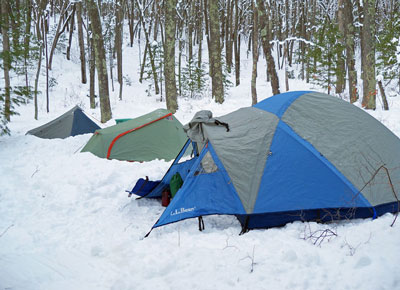 heavy duty rain fly with almost full coverage. This was the tent that we used for kayak camping before we had kids and it is much heavier than my single wall backpacking tent and takes a little longer to setup. I like to have the tent and rain fly combination because it is actually surprising how much heat stays trapped inside the double wall tent. I can keep my water bottle next to me just outside of the sleeping bag and it usually will not freeze even when temperatures drop down to the single digits. Although, I think you would be fine in a lightweight backpacking tent except for in really heavy and wet snow. One of the guys used only his rain fly and ground cloth and then built a wall of snow around the outside and he was fine.
heavy duty rain fly with almost full coverage. This was the tent that we used for kayak camping before we had kids and it is much heavier than my single wall backpacking tent and takes a little longer to setup. I like to have the tent and rain fly combination because it is actually surprising how much heat stays trapped inside the double wall tent. I can keep my water bottle next to me just outside of the sleeping bag and it usually will not freeze even when temperatures drop down to the single digits. Although, I think you would be fine in a lightweight backpacking tent except for in really heavy and wet snow. One of the guys used only his rain fly and ground cloth and then built a wall of snow around the outside and he was fine. 







